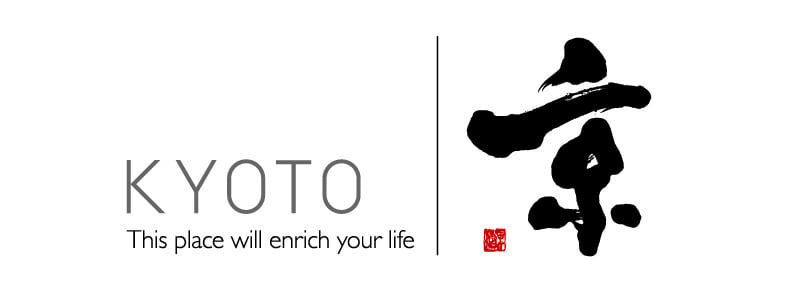Term archive
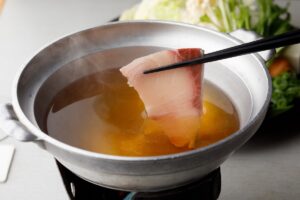
投稿タイプ:sightseeing
Ine Buri Shabu
The historic town of Ine, with its 230 boat houses lining the bay, is not only recognized as one of “Japan’s Most Beautiful Villages,” but it is also famous for being one of the three best areas in Japan to eat yellowtail (along with Himi City in Toyama Prefecture and the Goto Islands of Nagasaki Prefecture). From late autumn to winter, when the water temperature drops sharply, the deliciousness of the yellowtail spikes due to the increase in good-quality fat. There are quite a few restaurants that sell yellowtail, and the "buri shabu" cooking style is especially popular. In late autumn, many gourmet lovers from all over the country come for a chance to have Ine yellowtail served shabu-shabu style in boiling water. It just isn't as fresh anywhere else, and this area’s chefs specialize in preparing shabu-style yellowtail.
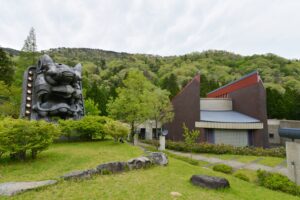
投稿タイプ:sightseeing
Japan Oni Cultural Museum
The Japan Oni Cultural Museum is appropriately located at the foot of the Oeyama mountain range, home to the most notorious "oni" (demon or ogre) in Japan, Shuten Doji. The museum explains local folklore and has displays of both national and international oni masks and artifacts. There is a large collection of onigawara, or oni-shaped roof tiles, which were used on buildings throughout history. The surrounding area has parks, places for families to explore on foot, including small waterfalls, rivers, hiking paths, and of course, friendly oni all over the place!
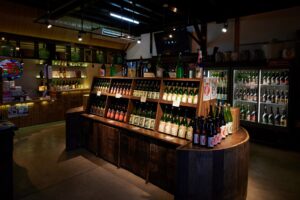
投稿タイプ:sightseeing
Kinoshita Sake Brewery
Founded in 1842, Kinoshita Sake Brewery is known for their Tamagawa sake brand. Immediately after taking his position with Kinoshita, master brewer Philip Harper, the industry's first non-Japanese master brewer, began production on raw sake and natural yeast sake products. Branded as "naturally prepared sake," these products contributed to Kinoshita Sake Brewery's name recognition due to their unique taste. Currently, master brewer Harper is actively working on the long-term aging of sake.
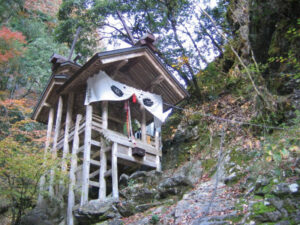
投稿タイプ:sightseeing
Motoise Naiku, Amanoiwato Shrine
This ancient shrine is one of the locations at which Amaterasu, the Shinto Goddess of the Sun, was enshrined before moving to Ise-jingu Grand Shrine in Mie Prefecture. In fact, this shrine predates Ise-jingu Grand Shrine by fifty-four years. It is also one of only two shrines in Japan to use black cedar torii gates. The shrine is a close walk from the local train station, and another nearby shrine called Amanoiwato Shrine, located in a ravine up the side of a boulder. There are legends that say Amaterasu lived underneath this rock during a period of seclusion.
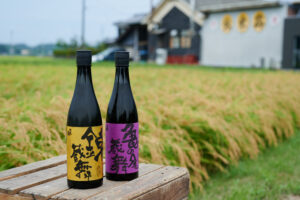
投稿タイプ:sightseeing
Takeno Sake Brewery
A family-run operation in its 6th generation, the head brewer at Takeno Sake Brewery has a chemistry background, and creativity to match his expertise. The brewery produces a range of sake, including luxury bottles. Takeno Sake Brewery also produces limited runs of some truly exclusive sake. They sell internationally as well, and have collaborated with establishments as prestigious as The Four Seasons.
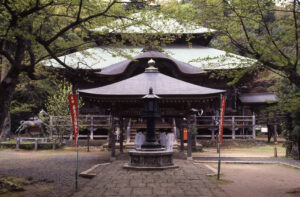
投稿タイプ:sightseeing
Matsuno-dera Temple
Matsuno-dera is temple 29 of a 33 temple pilgrimage route through western Japan. All of these temples enshrine the bodhisattva Kannon, Goddess of Mercy. Matsuno-dera Temple is also famous for the Buddhist dances that are performed here. The natural landscape at the temple is beautiful, too, and the grounds contain Japanese cultural assets.
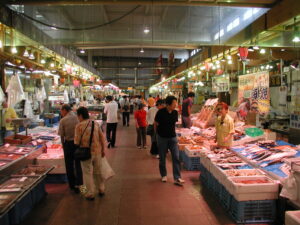
投稿タイプ:sightseeing
Tore Tore Center
Tore Tore Center is an indoor seafood market with a huge array of products, including Tango's own exceptional quality maizuru crab. It also has freshly prepared sushi, sashimi, baked and fried fish, and teriyaki dishes that can be purchased and eaten on the spot. In addition, there are large fish tanks, souvenir shops, and multiple restaurants (including different noodle options if you aren't feeling up for seafood).
This center is located quite close to Maizuru Port, where cruise ships are able to dock.
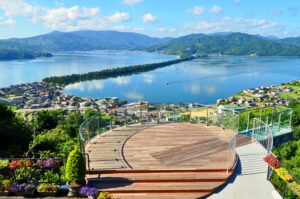
投稿タイプ:sightseeing
Kasamatsu Park
Kasamatsu Park is one of the two overlooks perfect for viewing Amanohashidate, one of Japan's Three Scenic Views. The park is located halfway between Motoise Kono Shrine and Nariai-ji Temple, and is accessible via chairlift or cable car.
At Kasamatsu Park, there is a gift shop, Ama Terrace Restaurant with excellent views of the Amanohashidate land bridge, as well as photo spots and places to view the land bridge upside down (by looking between your legs). This inverted view is famous and meant to look like a green dragon flying through the sky. From the park, visitors can also catch the mountain bus that runs between Kasamatsu Park and Nariai-ji Temple (one of the 33 temples on Japan's western pilgrimage route).
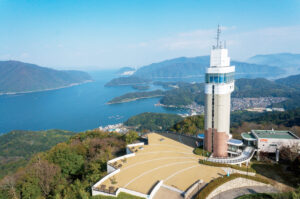
投稿タイプ:sightseeing
Goro Sky Tower
Mt. Goro-dake is situated between Higashi Maizuru and Nishi Maizuru. A panorama of the deeply indented shoreline and scattered islands—part of the beauty of Maizuru Bay, which has been chosen as the most scenic spot in the Kinki area—can be enjoyed from the observation tower at a height of 301.2 meters. There is an adjoining café where coffee, tea and a light meal can be enjoyed.
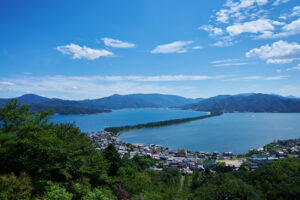
投稿タイプ:sightseeing
Amanohashidate
Amanohashidate is one of the “Three Most Famous Views in Japan.” The Amanohashidate sandbar is a natural land bridge described in legend as having been created by the deity Izanagi-no-mikoto as a path from the heavens to visit the deity Izanami-no-mikoto. Amanohashidate is a natural work of art created by the Sea of Japan and the Noda River, flowing from its source on Mt. Oe. The mysterious beauty, the white sands and green pine trees present a truly superb view. Some 8,000 pine trees grow in the sand along the roughly 3.6-kilometer bridge.
The shrine Hashidate Myojin (Amanohashidate-jinja Shrine), a famous freshwater well called Isoshimizu, and a road bridge that swings 90 degrees to allow ferries and barges to pass are among its additional points of interest. Visitors can walk or cycle from one end of Amanohashidate to the other. There are benches and rest areas along the way.
Amanohashidate is included in many “Best 100” lists: 100 Famous Pine Trees of Japan, 100 White Sand and Green Pine Sites of Japan, 100 Roads of Japan, 100 Beaches of Japan, 100 Famous Waters, 100 Historic Parks of Japan, 100 Beautiful Historic Landscapes of Japan, and 100 Geological Features of Japan.
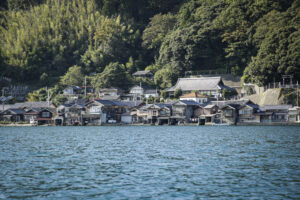
投稿タイプ:sightseeing
Ine Boathouses (Funaya)
Ine is a quaint seaside village in the "Kyoto by the Sea" area, situated in northern Kyoto Prefecture. This charming village hugs the coastline of the Sea of Japan and is famous for its unique wooden boathouses, known as "funaya." These boathouses are a hallmark of Ine, celebrated for their distinct architecture and historical importance. This design blends practicality with beauty, showcasing the seamless integration of human life with nature. The boathouses of Ine are a designated Group of Historic Buildings, a category under Japan's Historic Preservation Act, further highlighting their cultural importance.
The funaya of Ine date back to the Edo period (1603 to 1868). Each boathouse has two levels: the lower floor is used to store fishing boats and gear, with the floor almost flush with the waterline, giving the impression that the houses are floating. This tranquil setting has made Ine a popular backdrop for television shows and films, capturing the essence of traditional Japanese coastal life.
Many of the boathouses have been transformed into cozy cafes, restaurants, and inns. For a deeper experience, visitors can even spend the night in one of these charming converted inns. To get a different view, you can take a guided tour, such as the Ine Bay Cruise or a ride on a water taxi, allowing you to see the boathouses from the water.
While exploring, it's also worth taking a cycling tour to learn about Ine’s rich past, or heading up to the roadside station perched above the village for a stunning aerial view of the boathouses. Remember, many funaya are still private homes, so it's important to be respectful of the locals as you wander through the village.
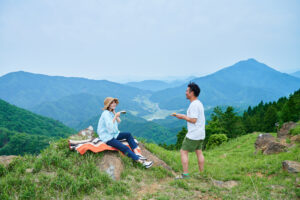
投稿タイプ:sightseeing
Mt. Oe
The Oeyama mountain range is known throughout Japan for its monster-slaying legends, and it is also a vast and rich natural environment. There is something fun to do in each season, including hiking with a view of fresh spring greenery or autumn leaves, and skiing in the winter. Because these are the stomping grounds of Japan's greatest "oni," or demon, Shuten Doji, the entrances to Mt. Oe hiking trails have numerous relics related to monsters.
